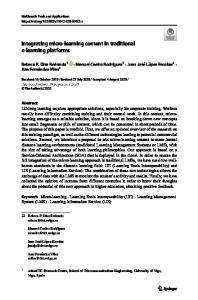Deep Learning Platforms
There are many deep learning platforms available such as Caffe, TensorFlow, MXNet, Torch, and Theano. Caffe (Convolutional Architecture for Fast Feature Embedding) is a deep learning framework, which originally was developed at the University of Californi
- PDF / 3,418,969 Bytes
- 141 Pages / 453.543 x 683.15 pts Page_size
- 82 Downloads / 367 Views
Wei Qi Yan
Computational Methods for Deep Learning Theoretic, Practice and Applications
Texts in Computer Science Series Editors David Gries, Department of Computer Science, Cornell University, Ithaca, NY, USA Orit Hazzan , Faculty of Education in Technology and Science, Technion—Israel Institute of Technology, Haifa, Israel
More information about this series at http://www.springer.com/series/3191
Wei Qi Yan
Computational Methods for Deep Learning Theoretic, Practice and Applications
123
Wei Qi Yan Auckland University of Technology Auckland, New Zealand
ISSN 1868-0941 ISSN 1868-095X (electronic) Texts in Computer Science ISBN 978-3-030-61080-7 ISBN 978-3-030-61081-4 (eBook) https://doi.org/10.1007/978-3-030-61081-4 © The Editor(s) (if applicable) and The Author(s), under exclusive license to Springer Nature Switzerland AG 2021 This work is subject to copyright. All rights are solely and exclusively licensed by the Publisher, whether the whole or part of the material is concerned, specifically the rights of translation, reprinting, reuse of illustrations, recitation, broadcasting, reproduction on microfilms or in any other physical way, and transmission or information storage and retrieval, electronic adaptation, computer software, or by similar or dissimilar methodology now known or hereafter developed. The use of general descriptive names, registered names, trademarks, service marks, etc. in this publication does not imply, even in the absence of a specific statement, that such names are exempt from the relevant protective laws and regulations and therefore free for general use. The publisher, the authors and the editors are safe to assume that the advice and information in this book are believed to be true and accurate at the date of publication. Neither the publisher nor the authors or the editors give a warranty, expressed or implied, with respect to the material contained herein or for any errors or omissions that may have been made. The publisher remains neutral with regard to jurisdictional claims in published maps and institutional affiliations. This Springer imprint is published by the registered company Springer Nature Switzerland AG The registered company address is: Gewerbestrasse 11, 6330 Cham, Switzerland
Preface
This book was drafted based on my recent lectures, talks, and seminars for our postgraduate students at the Auckland University of Technology (AUT), New Zealand. We integrate the materials of deep learning and machine learning as well as artificial neural networks together, refine the content, and publish this book so that more postgraduate students, especially those students who are working for their theses can benefit from our research and teaching work for the purpose of enlightening their projects. In this book, we organize our stuff and tell our story from easy to difficult in mathematics; we prepare our contents for knowledge transfer from the viewpoint of machine intelligence. We start from understanding artificial neural networks with the design of neurons and the activation fun
Data Loading...











